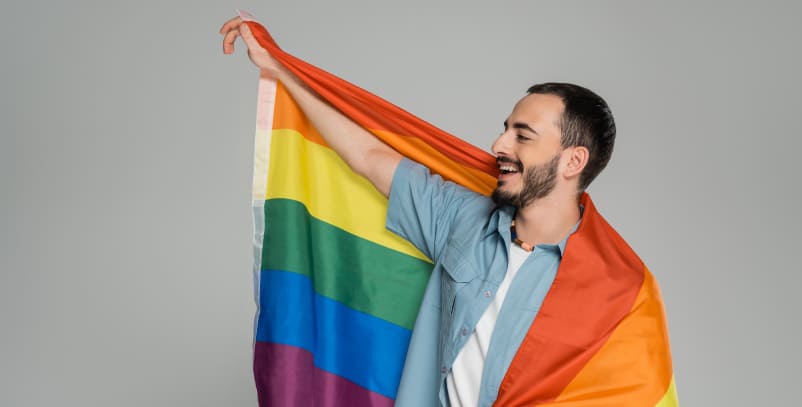
How the Fight for LGBTQ+ Rights Has Changed Perceptions of Sexuality
|
|
Time to read 3 min
|
|
Time to read 3 min
Major milestones in history are often tied to social movements that redefine the course of our societies. And when it comes to human sexuality, it's no exception… because sexuality is deeply intertwined with the social struggles that have championed LGBTQ+ rights.
If we look at recent decades, this movement has not only achieved significant legal and political progress, but it has also transformed the way we understand, talk about, and experience sexuality. That’s why, in this article, we’ll explore how (and to what extent) LGBTQ+ activism has influenced sex education, mental health, popular culture and the right to a free, diverse and visible sexuality.
For much of the 20th century, non-heteronormative identities (that being anyone who wasn’t heterosexual) were silenced, pathologized, and marginalized, both in the medical field and in mainstream culture. While LGBTQ+ visibility may now seem like a sudden achievement, it has actually been a gradual victory . One that has helped break down stigma and paved the way for more realistic, human, and diverse representations of sexuality.
From the decriminalization of homosexuality in many countries to the emergence of queer characters (a term used in English to describe people whose identities fall outside traditional norms) in film, television and literature, public perceptions of sexuality have significantly expanded. This shift has helped newer generations grow up with less fear and more positive, inclusive role models that reflect the full spectrum of human experience.
LGBTQ+ activism has also played a key role in challenging traditional models of sex education , which focused almost exclusively on heterosexual reproduction. Let’s not forget that, until very recently, sexuality was understood only in terms of reproduction and within the rigid male-female binary.
Thanks to the efforts of these communities, we now see more inclusive studies and educational spaces that address gender identity, sexual orientation, consent and respect for diversity. And contrary to what some might believe, this doesn’t just benefit LGBTQ+ individuals: it benefits society as a whole. Inclusive sex education helps reduce gender-based violence, improve sexual self-esteem and promote healthier, more equitable relationships.
The fight for LGBTQ+ rights has also had a significant impact on how mental health is approached through the lens of sexuality. Recognizing the psychological toll of discrimination —known as "minority stress" (Meyer, 2003)— has led to the development of more compassionate, inclusive and socially aware mental health strategies.
In addition, there is now a growing recognition of the right to pleasure and to experience sexuality fully —something made possible, in part, by the influence of queer discourse. What does that mean? It involves challenging the medicalized or moralistic views that have historically labeled certain identities or practices as deviant or pathological.
Legal milestones such as marriage equality, gender identity recognition, and anti-discrimination laws based on sexual orientation have helped legitimize and normalize new kinds of relationships, family models and greater respect for diverse expressions of sexuality. These legal advances don’t just guarantee rights—they also reshape social imagination and expand what’s seen as possible, desirable, or acceptable, for both queer and straight people, for cis and trans individuals alike.
As a result, many people are now able to live their sexuality more freely. Without hiding, without asking for permission and with pride. Because contrary to what many still seem to believe, pride isn’t about feeling superior to anyone else. It’s about being proud of who you are, loving yourself, and accepting yourself just as you are.
While resistance and inequality still exist, the direction is clear and unwavering: toward greater acceptance of sexual diversity as a fundamental pillar of today’s society.
Thanks to the momentum of LGBTQ+ movements, sexuality is no longer seen as a rigid category, but as a broad, dynamic, and valid spectrum in all its forms. Today, talking about sexuality means talking about rights, freedoms and inclusion.
And as a final thought and reminder: this shift doesn’t just impact those who identify as part of the LGBTQ+ community. It affects everyone. Because in a society where people are free to love and desire without fear and to truly be themselves, everyone benefits . That’s a collective victory worth celebrating… and continually protecting.
Meyer, I. H. (2003). Prejudice, social stress, and mental health in lesbian, gay, and bisexual populations: Conceptual issues and research evidence. Psychological Bulletin, 129(5), 674–697.
UNESCO. (2022). International technical guidance on sexuality education: An evidence-informed approach. Recuperado de https://www.unesco.org
Weeks, J. (2016). Sexuality (4ª ed.). Routledge.
Rubin, G. (1984). Thinking Sex: Notes for a Radical Theory of the Politics of Sexuality. In C. Vance (Ed.), Pleasure and Danger: Exploring Female Sexuality. Routledge.

